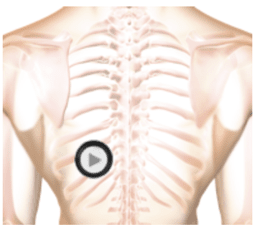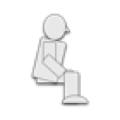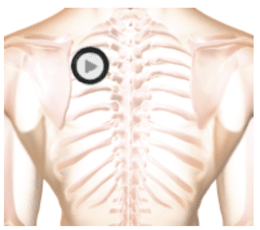Rales
Introduction
Welcome to our rales page. On this page we provide a definition of rales, including its clinical significance. We then compare rales against rhonchi with audio recordings and text. Finally, there is a link to the rales training lessons available on this site.
Our rales lesson can be found in this course. Secondly, our reference index is designed to provide quick access to stridor sounds, with audio tracks, listening guides and waveforms. Use this link for quick reference to heart and lung sounds.
Definition
Rales are abnormal lung sounds characterized by discontinuous clicking or rattling sounds. They can sound like salt dropped onto a hot pan or like cellophane being crumpled. Rales are believed to be caused by the opening of closed air spaces.
What about crackles? Crackles and rales mean the same thing. Refer to our 'crackles' page for more information on fine vs coarse crackles, along with patient recordings for each.
Rales Lung Sounds
Rales Sound Features
Listen for fine crackles, which are discontinuous, popping sounds similar to Velcro being pulled apart.
Rales Causes
When alveoli suddenly pop open with the presence of secretions, rales sounds are thought to be produced.
Rales Audio
The following recordings provide examples of what rales sounds like.


The patient's position is seated.
Waveform
Compare To Rhonchi
Rhonchi Listening Tips
Listen for lower pitched, snoring or rattle-like sounds.
Rhonchi Causes
Rhonchi are caused by secretions or obstructions in the large airways.
Rhonchi Audio
The following recordings provide examples of what rhonchi sounds like.
Rhonchi Audio


The patient's position is seated.
Respiratory Sounds Reference Guide
Our auscultation reference guide provides quick access to this sound as well as many other adventitious sounds. Each sound is described also with an audio recording and waveform.Quick Links to Other Breath Sounds
While we have many breath sound lessons and quick references on this website. Please use the links below.
Bronchial Breath Sounds
Adventitious Breath Sounds
Adventitious Lung Sounds
Wheezing
Rhonchi
Fine and Coarse Crackles
Rales
Egophony
Auscultate
Auscultation Lung Sounds Audio
Related Lessons
| Basics of Lung Sounds
The goal of this basic course in lung sounds is to improve auscultation observational skills. We focus on describing important breath sounds and in providing recordings of each. Many students find that waveform tracings aid in learning lung sounds; we have included dynamic (moving cursor) waveforms with each lesson. The anatomy pages use illustrations to reveal an example of each lung sound (anatomy not yet available on smartphones). |
| 1 | Vesicular - Normal |
| 2 | Crackles - Fine (Rales) |
| 3 | Crackles - Coarse (Rales) |
| 4 | Wheeze |
| 5 | Rhonchi - Low Pitched Wheezes |
| 6 | Bronchial |
| 7 | Pleural Rubs |
| 8 | Bronchovesicular |
| Intermediate Lung Sounds
The goal of this intermediate course is to expand your observational skills when auscultating breath sounds. The course lessons include voiced sounds: bronchophony, egophony and whispered pectoriloquy. We also provide auscultation lessons on several types of wheezes, crackles and stridor. Each of these lung sound lessons includes audio, text and dynamic waveform. The anatomy pages use illustrations to reveal an example of each lung sound (anatomy not yet available on smartphones). |
| 1 | Vesicular - Diminished |
| 2 | Bronchophony - Healthy |
| 3 | Bronchophony - Abnormal |
| 4 | Egophony - e |
| 5 | Egophony - a |
| 6 | Whispered Pectoriloquy - Healthy |
| 7 | Whispered Pectoriloquy - Abnormal |
| 8 | Wheeze - Expiratory |
| 9 | Wheeze - Monophonic |
| 10 | Wheeze - Polyphonic |
| 11 | Crackles - Early Inspiratory (Rales) |
| 12 | Crackles - Late Inspiratory (Rales) |
| 13 | Stridor |
Authors and Reviewers
These authors contributed the sound recordings and text descriptions found in this section: Diane Wrigley, PA, William French, and David Lieberman.Medical review by Dr. Barbara Erickson, PhD, RN, CCRN.
Special thanks for the medical leadership of Dr Raymond Murphy.
Authors and Reviewers
-
Heart sounds by Dr. Jonathan Keroes, MD and David Lieberman, Developer, Virtual Cardiac Patient.
- Lung sounds by Diane Wrigley, PA
- Respiratory cases: William French
-
David Lieberman, Audio Engineering
-
Heart sounds mentorship by W. Proctor Harvey, MD
- Special thanks for the medical mentorship of Dr. Raymond Murphy
- Reviewed by Dr. Barbara Erickson, PhD, RN, CCRN.
-
Last Update: 12/11/2022
Sources
-
Heart and Lung Sounds Reference Library
Diane S. Wrigley
Publisher: PESI -
Impact Patient Care: Key Physical Assessment Strategies and the Underlying Pathophysiology
Diane S Wrigley & Rosale Lobo - Practical Clinical Skills: Lung Sounds
- Essential Lung Sounds
Diane S. Wrigley, PA-C
Published by MedEdu LLC - PESI Faculty - Diane S Wrigley
-
Case Profiles in Respiratory Care 3rd Ed, 2019
William A.French
Published by Delmar Cengage - Essential Lung Sounds
by William A. French
Published by Cengage Learning, 2011 - Understanding Lung Sounds
Steven Lehrer, MD
- Clinical Heart Disease
W Proctor Harvey, MD
Clinical Heart Disease
Laennec Publishing; 1st edition (January 1, 2009)
?
main Pv# 1 , InitialPages , pix False , #Drops 0 ;